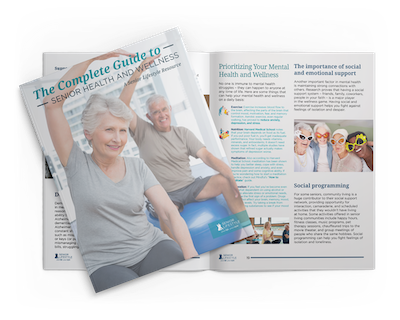Arthritis isn’t inevitable for older people, but 23.7% of adults – about 58.5 million people – have the disease, according to the U.S. Centers for Disease Control and Prevention. Those numbers are expected to increase with the aging of the American population. By 2040, an estimated 78.4 million people will be living with arthritis, the CDC says.
Arthritis treatments to ease suffering are highly sought after. Find out about the main types of arthritis, how to live with arthritis, what treatments are available and more.
>> Read “7 Ways Senior Communities Promote Health & Wellness”
What Are the 4 Common Types of Arthritis?
Arthritis refers to the inflammation or swelling of joints in the body, which causes pain and stiffness. There are more than 100 conditions that can be called arthritis, according to the CDC. There are four common types of arthritis that older people may face:
1. Osteoarthritis
Osteoarthritis is the most common type of arthritis, affecting more than 32.5 million American adults. It sometimes is called degenerative joint disease, frequently occurring in the hands, hips and knees when the joint cartilage starts to break down.
2. Rheumatoid Arthritis
Rheumatoid arthritis (RA) is an autoimmune and inflammatory disease. With RA, the body’s immune system mistakenly attacks healthy cells, causing inflammation. RA typically attacks many joints at once in the hands, wrists and knees.
3. Gout
Gout affects one joint at a time, many times the joint of the big toe. It can flare up and go into remission many times. Repeated incidents of gout can lead to a condition called gouty arthritis.
4. Fibromyalgia
Fibromyalgia is considered an arthritis-related condition. It causes widespread pain in the body along with sleep problems, fatigue and more. Fibromyalgia often occurs with other types of arthritis.
What Are Some Typical Treatments for Arthritis?
When considering how to treat arthritis, methods can run from medical to holistic. Among the methods are the following.
Medication
Medications are frequently used to ease the joint pain of arthritis, along with other symptoms. Most of the medications are used to reduce inflammation, which causes arthritis pain.
Some of the more common medications used to treat arthritis include:
- Corticosteroids – These prescription medications attack inflammation and are often used with other therapies.
- Disease modifying anti-rheumatic drugs (DMARDs) – These drugs can inhibit the progression of the disease and can reduce symptoms.
- Over-the-counter pain relievers – These include acetaminophen, ibuprofen and non-steroidal anti-inflammatory drugs (NSAIDs) like aspirin. Acetaminophen is widely considered the safest for long-term use.
- Prescription NSAIDs – These medications can control inflammation, pain and other symptoms when used along with other treatments.
- Prescription pain relievers – These are intended for short-term use under the supervision of a medical professional.
- Supplements – Glucosamine and chondroitin may ease arthritis attacks.
- Topical creams, gels and ointments – Topical NSAIDs are considered to be safer than the oral version of the medication.
Physical Therapy
Physical therapy can help reduce joint stiffness, improve range of motion and strengthen the muscles that support damaged joints.
Therapy is a long-term treatment usually employed as part of an overall program. While it may not be effective for everyone, physical therapy should be given time to work, from three to six months.
Other Methods
There are other things that you can do to treat arthritis. Among them:
- Chiropractic adjustments – Some people feel less pain and stiffness when the joints affected by osteoarthritis are manipulated.
- Hot and cold therapy – Ice packs or heat applied to joints can ease inflammation and pain.
- Nerve stimulation – This technique, transcutaneous electrical nerve stimulation (TENS), uses light electrical pulses to change the pain response.
Surgery – Severe cases of arthritis may require surgery to repair damaged joints.

Download The Complete Guide to Senior Health and Wellness
As people grow older, their health and wellness needs change. Read our eBook, "The Complete Guide to Health & Wellness for Seniors" for everything you need to know about staying healthy and happy as we age.
Download the GuideHow Can You Manage Arthritis?
There are a few steps you can take on your own to ease your struggle with arthritis. The CDC recommends:
Exercise
Physical activity can reduce pain, improve function, help mood and boost the quality of life for seniors with arthritis.
The U.S. Department of Health and Human Services recommends 150 minutes of moderate physical activity for adults each week. This may include low-impact exercises such as light strength training, swimming, walking and yoga.
>> Read “7 Best Exercises for Seniors (and a Few to Avoid!)”
Self-management
This is more than taking medication. Many adults with arthritis are encouraged to find out what they can about their disease so they can plan strategies. The CDC recommends self-management education programs that can help improve the quality of life for people who have arthritis.
These workshops can share strategies for pain management, stress reduction, communicating with health professionals, and more.
Weight Loss
Being overweight adds extra stress to damaged joints. Losing weight can lessen the pain by relieving some of that pressure on hips and knees.
A weight-loss program, whether focusing on diet or other lifestyle changes, should also include some moderate exercise. Counseling should be part of the weight management program.
The CDC’s Healthy Weight site has more about weight loss.
Live in an Atmosphere of Health and Wellness
A senior community can come alongside those with arthritis to provide support for good health. Learn more about the ways Senior Lifestyle provides activities and wellness programs. Contact us to find out more about Senior Lifestyle communities today.

